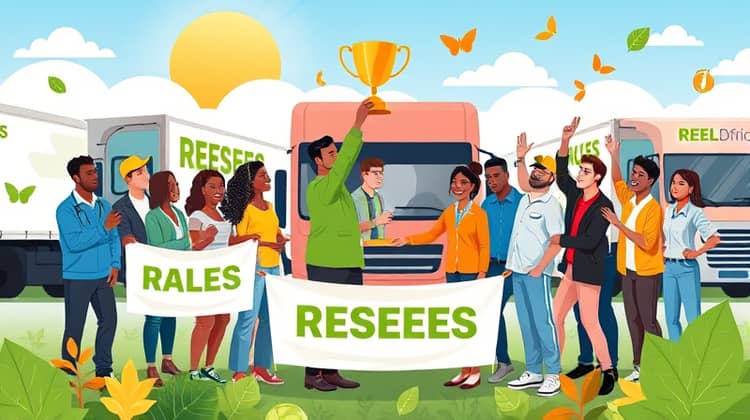Reducing Transportation Costs: Top 10 Strategies for Maximum Savings

Transportation costs continue to be a significant challenge for businesses of all sizes. Reducing these expenses not only improves profit margins but also enhances overall operational efficiency. By implementing effective strategies to lower transportation costs, companies can gain a competitive advantage in their respective markets.
In this article, we will explore the top ten strategies for maximizing savings in transportation. Each strategy provides practical insights that can help businesses streamline their operations and minimize expenditures, leading to sustainable growth.
1. Optimize Routes

One of the most effective ways to reduce transportation costs is by optimizing routes. This process involves analyzing and changing routes to find the most efficient paths for deliveries, which can help minimize fuel consumption and travel time.
Utilizing route optimization software can significantly aid in this process. Such tools not only determine the best routes but also take into account variables such as traffic patterns, delivery windows, and vehicle capacities.
- Use GPS and mapping software for real-time navigation improvements.
- Conduct regular route reviews to identify inefficiencies.
- Employ predictive analytics to forecast traffic patterns and conditions.
By optimizing routes, companies can experience substantial savings in fuel costs while enhancing customer satisfaction through timely deliveries.
2. Embrace Technology

In today’s digital age, embracing technology is no longer optional but essential for businesses looking to reduce transportation costs. Innovations such as telematics, fleet management software, and inventory tracking systems can revolutionize transportation efficiency.
By leveraging these technologies, businesses can monitor vehicle performance, reduce operational downtime, and ensure effective logistics management.
- Adopt telematics systems for monitoring vehicle usage and performance.
- Implement fleet management software for optimizing routes and schedules.
- Utilize mobile applications for real-time communication and updates with drivers.
The integration of technology not only improves efficiency but can also enhance data collection and analysis, allowing businesses to make more informed decisions.
3. Regular Vehicle Maintenance

Maintaining vehicles on a regular basis is crucial to minimizing transportation costs. Regular maintenance checks can prevent costly repairs and breakdowns, which can disrupt operations and lead to increased expenses.
Developing a maintenance schedule that includes inspections, oil changes, tire rotations, and brake checks is essential in ensuring the reliability of the fleet. This proactive approach can extend the lifespan of the vehicles and improve fuel efficiency.
4. Fuel Efficiency

Fuel costs are a significant portion of transportation expenses. Improving fuel efficiency should be a top priority for businesses that rely on vehicles for operations.
Simple changes in driving behavior, such as reducing idling time, maintaining steady speeds, and ensuring proper tire inflation can greatly enhance fuel efficiency.
- Encourage drivers to maintain steady speeds and avoid rapid acceleration.
- Regularly check tire pressure to ensure vehicles run efficiently.
- Explore alternative fuels or hybrid vehicle options for fleets.
Implementing these fuel-efficient practices not only saves money but also contributes to environmental sustainability.
5. Negotiate Better Rates

Negotiating better rates with carriers and suppliers is an effective way to reduce transportation costs. Building strong relationships with service providers can lead to favorable pricing agreements and discounts.
Businesses should regularly review contracts and seek competitive quotes to ensure they are receiving the best rates possible for their shipping needs.
- Establish long-term partnerships with service providers for better rates.
- Regularly review and renegotiate contracts to adapt to changing market conditions.
- Utilize bidding processes for selecting carriers to encourage competitive pricing.
By leveraging their purchasing power, businesses can secure significant savings and ensure they remain competitive in their market.
6. Consider Outsourcing

Outsourcing transportation logistics can lead to cost savings for many businesses. Third-party logistics (3PL) providers often have more resources and expertise, enabling them to manage transportation more efficiently than an in-house team.
Moreover, outsourcing can free up internal resources, allowing businesses to focus on their core competencies and strategic initiatives.
7. Use Alternative Transportation Modes

Exploring alternative transportation modes can provide opportunities for cost savings. Depending on the nature of the goods being shipped, other modes such as rail, sea, or even bicycle deliveries may be more cost-effective than traditional trucking.
Assessing the feasibility of these options can lead to reduced costs and improved delivery times in some cases.
- Consider rail transport for long-distance shipping to reduce costs.
- Utilize shipping containers for bulk goods to optimize space and minimize costs.
- Look into bicycle or electric vehicle delivery for urban areas to reduce fuel expenses.
In certain scenarios, diversifying transport modes can unlock new avenues for savings and operational efficiencies.
8. Reduce Empty Miles

Empty miles, or the distance traveled by a vehicle without any cargo, represent a significant waste of resources in the transportation sector. Implementing strategies to minimize these miles can lead to substantial savings.
Using freight matching services or software can help fill empty loads, ensuring that trucks are utilized to their full capacity, thus optimizing operational efficiency.
9. Implement a Driver Incentive Program

Creating a driver incentive program encourages safe and efficient driving behaviors. When drivers are motivated to perform better through bonuses or recognition, they are more likely to prioritize fuel efficiency and reduce operational risks.
Incentives can also lead to better job satisfaction, retention rates, and overall improvements in performance.
- Establish benchmarks for performance based on fuel consumption or delivery timings.
- Provide financial bonuses or recognition for top-performing drivers.
- Encourage safe driving practices through training and educational programs.
These incentives not only benefit the company's bottom line but also contribute to a positive work culture and employee engagement.
10. Monitor and Analyze Costs

Finally, continuous monitoring and analysis of transportation costs are essential for identifying areas for improvement. Utilizing data analytics to track expenses can highlight trends and pinpoint inefficiencies within logistics operations.
Establishing key performance indicators (KPIs) related to transportation can provide valuable insights, enabling businesses to make data-driven decisions.
Conclusion

Reducing transportation costs is a multifaceted endeavor that requires a comprehensive approach. By implementing these top strategies, businesses can create a sustainable transportation model that not only minimizes costs but also enhances overall efficiency.
Investing time and resources into optimizing transportation can result in long-term benefits and create significant savings for organizations in today's competitive business landscape.






